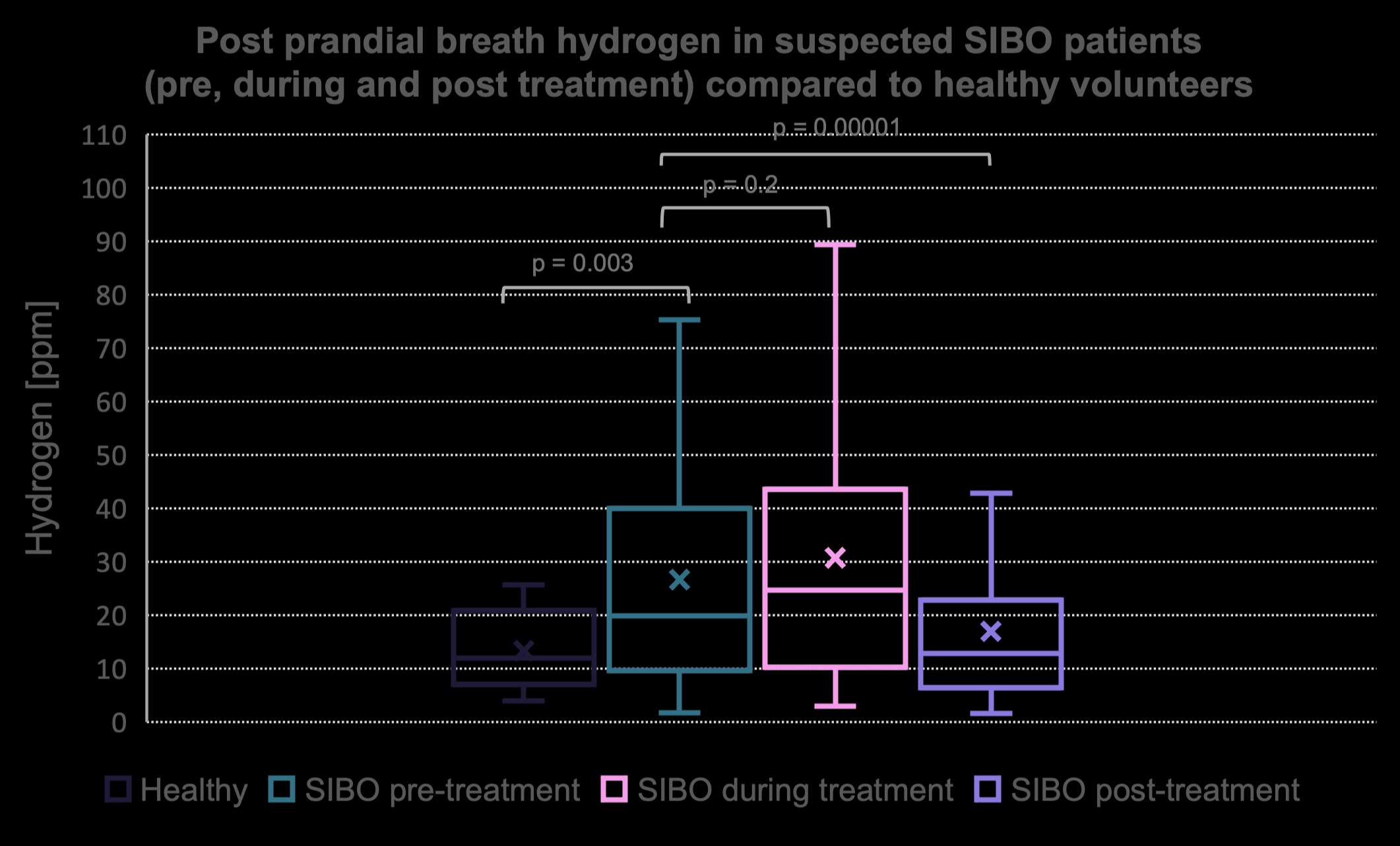Back


Poster Session D - Tuesday Morning
Category: Small Intestine
D0641 - The Use of Post-Prandial Breath Hydrogen to Monitor Antibiotic-Induced Changes in the Activity of the Gut Microbiome
Tuesday, October 25, 2022
10:00 AM – 12:00 PM ET
Location: Crown Ballroom

Has Audio
- PP
Pankaj Pasricha, MD, MBBS
Johns Hopkins University
Baltimore, MD
Presenting Author(s)
Guillermo Barahona, MD, MBA1, Aine Moran, BSc2, Barry McBride, BEng, MSc2, Kedrick Harrison, MPH2, Luisa Villatoro, MD, MBA1, Robert Burns, BS1, Bo Konings, BSc3, Robert Bulat, MD, PhD1, Megan McKnight, PA-C1, Claire Shortt, BSc, PhD2, Pankaj Jay Pasricha, MD, MBBS1
1Johns Hopkins University, Baltimore, MD; 2FoodMarble, Dublin, Dublin, Ireland; 3Johns Hopkins University, Houthalen-Helchteren, Limburg, Belgium
Introduction: Small intestinal bacterial overgrowth (SIBO) is a common condition that is associated with a range of non-specific GI symptoms. Patients are often prescribed an empirical trial of antibiotics, however, response to treatment can vary. Due to the heterogeneous nature of symptoms experienced, post-prandial breath hydrogen (PPH2) may assist in identifying beneficial changes in the activity of the gut microbiome in those with a dysbiotic phenotype.
Methods: 16 suspected SIBO patients measured their PPH2 using an at-home, app-connected breath analyzer (AIRE®, FoodMarble). Readings were taken at 0, 30, 60, and 90 min after their morning and evening meals for 7 days pre and post-treatment. 14/16 patients followed this protocol during antibiotic treatment. Six controls measured their PPH2 levels for 7 days. Gas normalization was defined as +2 SD of the mean PPH2 in controls.
Results: Patients produced significantly more PPH2 (p=0.003), 27 ppm ± 22 ppm (mean ± SD) than controls (13 ppm ± 7 ppm). 5/14 patients saw a transient increase (p=0.2) of 23 ppm ± 23 ppm (mean delta ± SD) of PPH2 during treatment. Post-treatment, patients produced significantly less PPH2 (p=0.00001), 17 ppm ± 13 ppm, more closely matching that of healthy controls, Fig 1.
Discussion: For the first time, PPH2 was tracked before, during, and after antibiotic treatment. PPH2 was significantly greater in patients. Interestingly, for some patients, PPH2 increased during the treatment period, likely due to a dynamic rearrangement of certain microbial populations. Post-treatment, the level of PPH2 in patients was more similar to that of healthy volunteers. The collection of PPH2 data may be useful to identify those who produce elevated gas levels due to dysbiosis and to determine the normalization of their microbiome in response to antibiotics.

Disclosures:
Guillermo Barahona, MD, MBA1, Aine Moran, BSc2, Barry McBride, BEng, MSc2, Kedrick Harrison, MPH2, Luisa Villatoro, MD, MBA1, Robert Burns, BS1, Bo Konings, BSc3, Robert Bulat, MD, PhD1, Megan McKnight, PA-C1, Claire Shortt, BSc, PhD2, Pankaj Jay Pasricha, MD, MBBS1. D0641 - The Use of Post-Prandial Breath Hydrogen to Monitor Antibiotic-Induced Changes in the Activity of the Gut Microbiome, ACG 2022 Annual Scientific Meeting Abstracts. Charlotte, NC: American College of Gastroenterology.
1Johns Hopkins University, Baltimore, MD; 2FoodMarble, Dublin, Dublin, Ireland; 3Johns Hopkins University, Houthalen-Helchteren, Limburg, Belgium
Introduction: Small intestinal bacterial overgrowth (SIBO) is a common condition that is associated with a range of non-specific GI symptoms. Patients are often prescribed an empirical trial of antibiotics, however, response to treatment can vary. Due to the heterogeneous nature of symptoms experienced, post-prandial breath hydrogen (PPH2) may assist in identifying beneficial changes in the activity of the gut microbiome in those with a dysbiotic phenotype.
Methods: 16 suspected SIBO patients measured their PPH2 using an at-home, app-connected breath analyzer (AIRE®, FoodMarble). Readings were taken at 0, 30, 60, and 90 min after their morning and evening meals for 7 days pre and post-treatment. 14/16 patients followed this protocol during antibiotic treatment. Six controls measured their PPH2 levels for 7 days. Gas normalization was defined as +2 SD of the mean PPH2 in controls.
Results: Patients produced significantly more PPH2 (p=0.003), 27 ppm ± 22 ppm (mean ± SD) than controls (13 ppm ± 7 ppm). 5/14 patients saw a transient increase (p=0.2) of 23 ppm ± 23 ppm (mean delta ± SD) of PPH2 during treatment. Post-treatment, patients produced significantly less PPH2 (p=0.00001), 17 ppm ± 13 ppm, more closely matching that of healthy controls, Fig 1.
Discussion: For the first time, PPH2 was tracked before, during, and after antibiotic treatment. PPH2 was significantly greater in patients. Interestingly, for some patients, PPH2 increased during the treatment period, likely due to a dynamic rearrangement of certain microbial populations. Post-treatment, the level of PPH2 in patients was more similar to that of healthy volunteers. The collection of PPH2 data may be useful to identify those who produce elevated gas levels due to dysbiosis and to determine the normalization of their microbiome in response to antibiotics.

Figure: Fig 1: Post prandial breath hydrogen of suspected SIBO patients (n=16) before, during and after antibiotic treatment compared to healthy controls (n=6).
Disclosures:
Guillermo Barahona indicated no relevant financial relationships.
Aine Moran: FoodMarble – Employee.
Barry McBride: FoodMarble – Employee.
Kedrick Harrison: FoodMarble – Employee.
Luisa Villatoro indicated no relevant financial relationships.
Robert Burns indicated no relevant financial relationships.
Bo Konings indicated no relevant financial relationships.
Robert Bulat: Enterra Inc (subsidiary of Medtronic) – Advisor or Review Panel Member. Neurogastrix pharmaceuticals – Independent Contractor. Vanda pharmaceuticals – Independent Contractor.
Megan McKnight indicated no relevant financial relationships.
Claire Shortt: FoodMarble – Employee.
Pankaj Jay Pasricha: GI Scientific – Consultant. Glyscend – Consultant. Kyttaro – Consultant. Neurogastrx – Stock Shareholder. P4Microbiome – Consultant. Pendulum – Consultant. Takeda – Consultant. Vanda – Consultant.
Guillermo Barahona, MD, MBA1, Aine Moran, BSc2, Barry McBride, BEng, MSc2, Kedrick Harrison, MPH2, Luisa Villatoro, MD, MBA1, Robert Burns, BS1, Bo Konings, BSc3, Robert Bulat, MD, PhD1, Megan McKnight, PA-C1, Claire Shortt, BSc, PhD2, Pankaj Jay Pasricha, MD, MBBS1. D0641 - The Use of Post-Prandial Breath Hydrogen to Monitor Antibiotic-Induced Changes in the Activity of the Gut Microbiome, ACG 2022 Annual Scientific Meeting Abstracts. Charlotte, NC: American College of Gastroenterology.
